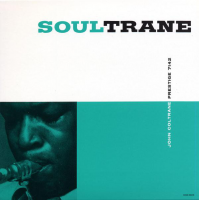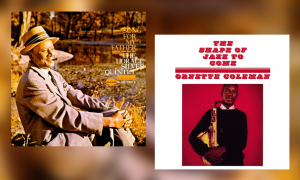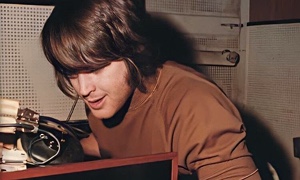Home » Jazz Articles » Building a Jazz Library » John Coltrane: An Alternative Top Ten Albums
John Coltrane: An Alternative Top Ten Albums

Keep listening. Never become so self-important that you can’t listen to other players. Live cleanly. Do right. You can improve as a player by improving as a person. It’s a duty we owe ourselves.
—John Coltrane
Coltrane is a role model for all, not just musicians. He was a gentle, decent, modest, non-judgemental, generous, principled human being. But discussion of his character is for another article. This one deals simply with his recorded legacy.
New millennial jazz starts with Coltrane, and albums from his catalogue, which continues to grow as previously unreleased recordings are discovered, are the backbone of a modern jazz library. Coltrane's catalogue is dominated by three labels: Prestige, for whom he recorded as leader between 1956 and 1958, Atlantic, his home from 1959 to 1961, and Impulse!, to which he signed in 1961 and where he stayed until he passed, aged only forty, in 1967. His output on all three labels falls within the hi-fidelity age, and the Prestige and Impulse! discs are further enhanced by being engineered in the most part by Rudy Van Gelder.
Coltrane's Essential Top Ten Albums chart might go something like this: Thelonious Monk Quartet With John Coltrane At Carnegie Hall (Blue Note, recorded 1957, released 2005), Giant Steps (Atlantic, 1960), My Favorite Things (Atlantic, 1961), Africa / Brass (Impulse!, 1961), Coltrane (Impulse!, 1962), Live At The Village Vanguard (Impulse!, 1962), A Love Supreme (Impulse!, 1965), One Down, One Up: Live At The Half Note (Impulse!, recorded 1965, released 2005), Ascension (Impulse!, 1966) and Interstellar Space (Impulse!, recorded 1967, released 1974).
This Alternative chart—note it is An Alternative, not The Alternative—cherry picks another ten discs. The first three are early period Coltrane, on the Prestige label. Most of Coltrane's Prestige albums are far, far better than received wisdom maintains them to be. The third one here, a sideperson date with tenor player Gene Ammons, is included because it features Coltrane on alto saxophone, the only album featuring him on that instrument (except for one track on Impulse!'s posthumous Stellar Regions, recorded in 1967). The rest of the Alternatives come from Coltrane's Impulse! catalogue, except for one which came out on Pablo Live.
Happy listening.
GET ON THE LOVETRANE: AN ALTERNATIVE TOP TEN ALBUMS
These albums are presented in order of recording, not of release. John Coltrane
John Coltrane John Coltrane With The Red Garland Trio
Prestige, 1958
Coltrane's second own-name album was recorded in late summer 1957, a year in which two events impacted strongly on his playing. In the spring, he put heroin and alcohol behind him once and for all and, by the time he made this album (later repackaged as Traneing In), he was part of the Thelonious Monk quartet's historic extended engagement at the Five Spot. Monk was Coltrane's last formative influence. The album—which features the contemporary Miles Davis quintet without Davis— shows how dramatically Coltrane had developed since his co-headliner with pianist Tadd Dameron, Mating Call (Prestige), recorded in winter 1956, and even since his own-name debut, Coltrane (Prestige), recorded in spring 1957. By summer 1957, Coltrane had yet to reach his full glory, but his trajectory was clear and so was his genius. His signature sound—a soaring, wailing, human-voice cry, aggressive and virtuosic on fast pieces, serene and sensitive on ballads—was approaching perfection, and the rapid-fire stacked-chord runs which critic Ira Gitler was soon to dub "sheets of sound" were increasingly in evidence, particularly on a high octane reading of Irving Berlin's "Soft Lights And Sweet Music." There are two Coltrane originals, both of them blues, including the intense "Traneing In." Pianist Red Garland, bassist Paul Chambers and drummer Art Taylor cook throughout.
 John Coltrane
John ColtraneSoultrane
Prestige, 1958
The same lineup reassembled five months later for Soultrane. Coltrane's sound is now as good as fully formed and Gitler's sheets of sound blaze on another up-tempo reading of an Irving Berlin tune, "Russian Lullaby." There are no originals. It is possible that Coltrane was holding back on these at Prestige because the label's owner, Bob Weinstock, would not allow him to own the publishing rights, claiming them instead for Prestige Music. Certainly, the originals started tumbling out once Coltrane had quit Prestige for Atlantic, which let him form his own publishing company, Jowcol (for John William Coltrane). There are exquisite readings of Billy Eckstine's "I Want To Talk About You," which remained one of Coltrane's favourite ballads, and Freddie Lacey's haunting "Theme For Ernie," written in memory of the recently deceased alto saxophonist Ernie Henry. Coltrane himself considered Soultrane almost as good as his Atlantic debut, the all-originals Giant Steps, his first stone masterpiece.
 Gene Ammons And His All Stars
Gene Ammons And His All StarsGroove Blues
Prestige, 1961
In January 1958, Coltrane recorded four tracks with old-school tenor player Gene Ammons, three of which appear on this four-track album, an amiable, hard-swinging blowing session. As mentioned above, Coltrane is on alto. Paul Quinchette is the second tenor, Pepper Adams is on baritone and Jerome Richardson is on flute. All but one of the tunes, Richard Rodgers and Oscar Hammerstein's "It Might As Well Be Spring," were written by Mal Waldron, the pianist on the date. Coltrane was booked to play second tenor but at the last minute, when it looked like Ammons might not make it, Quinchette was brought in. When Ammons did arrive, Coltrane was asked to play alto (using an instrument borrowed from the writer and amateur saxophonist Ira Gitler, who was, one assumes, present at Van Gelder's studio). Coltrane does not approach the alto any differently than the tenor. His solos are not particularly noteworthy, but the alto brings historical interest. The fourth tune from the session was included on Ammons' The Big Sound (Prestige, 1958). The date was Coltrane's final sideperson recording for Prestige. (His final sideperson appearance on any label was on Miles Davis' 1961 Columbia album Someday My Prince Will Come, where Coltrane guests, alongside Hank Mobley, on two tunes. His seventy-eight-second solo on the title track is the highpoint of the album and, despite its brevity, it is one of the most sublime solos Coltrane ever recorded).
 John Coltrane Quartet
John Coltrane QuartetBallads
Impulse!, 1963
In 1959, Coltrane, who was hyper self-critical all his life, told his wife Naima, "I can't play ballads." He totally laid those doubts to rest on the Great American Songbook celebration Ballads, leading what was to become known as his classic quartet, with pianist McCoy Tyner, bassist Jimmy Garrison and drummer Elvin Jones. Predictably, some of Coltrane's supporters in the critical fraternity (and it was in the 1960s still overwhelmingly a male network) cried foul, suggesting that producer Bob Thiele had strong-armed Coltrane into making a "commercial" album. Among the conspiracy theorists was Frank Kofsky, later the author of the admirable Black Nationalism and the Revolution in Music (Pathfinder Press, 1970). In a summer 1966 interview with Coltrane for Jazz and Pop magazine, Kofsky asked if Impulse! had applied any such pressure. Coltrane replied that the label probably did want a "diversified sort of catalogue, and I see nothing wrong with this...[but those] ballads that came out were definitely ones I felt at this time. I chose them. It seemed to be something that was laying around in my mind, from my youth or somewhere, and I just had to do them." In the same interview, Coltrane also said, "Most of the songs that I even write now, the ones that I even consider songs, are ballads...I mean, I really love these things." Most of the eight tracks clock in at around three to five minutes. They are precious jewels, albeit miniature ones.
 John Coltrane
John ColtraneAfro Blue Impressions
Pablo Live, recorded 1963, released 1977
The intensity of Coltrane's first live album, Live At The Village Vanguard, featuring reed player Eric Dolphy, is not matched on this more equable, yet still fired up, 2xCD set culled from the classic quartet's winter 1963 tour of Europe. The nine tracks were selected by Norman Granz, who had arranged the tour and who owned the Pablo label. Coltrane is front and centre throughout and the sound is generally good, although Tyner and Garrison get a bit lost occasionally, particularly when Coltrane and Jones get stuck into steaming tenor and drums duets on "Chasin' The Trane," "Cousin Mary" and "Impressions." Contemporary reviews confirm that Coltrane got into some full-on paintstripping a la Village Vanguard on the tour, but Granz chose not to include these on Afro Blue Impressions. No matter; what is preserved is outstanding. The other tunes are "Lonnie's Lament," "Naima," "Afro Blue," "I Want To Talk About You," "Spiritual" and "My Favorite Things," the main soprano feature.
 John Coltrane Quartet
John Coltrane QuartetCrescent
Impulse!, 1964
Coming so close in the Coltrane chronology to A Love Supreme, the classic quartet's altogether beautiful Crescent, recorded just six months earlier, tends to get lost in the slipstream. But if the later album is the alpha and the omega of Coltrane's legacy, Crescent is still alpha-plus. The album consists of five new originals: "Crescent," "Wise One," "Bessie's Blues," "Lonnie's Lament" (which was sneak previewed on Afro Blue Impressions) and "The Drum Thing." Crescent is sometimes called a "mournful" album, which is strange. Certainly, there is a wistful quality to "Wise One" (which is dedicated to Coltrane's wife Naima), but it is not the dominant emotion, and while there is sadness in "Lonnie's Lament," the piece is played with such vigour as to come across more like a celebration of a life than a conventional lament. Ditto the up-tempo romp "Bessie's Blues." Indeed, lyricism and positivity are to the fore throughout the album. (A note on sleeve notes: On the inside cover of the classic quartet's first Impulse! studio album, 1962's Coltrane, Bob Thiele wrote that there was no detailed sleeve note because "true jazz lovers will understand the music [without such an explanation]." The sleeve norm during the LP era was to have a prominent critic mansplaining what was in the grooves, a practice which had the added benefit of functioning as legal payola. Leroi Jones, as Amiri Baraka was still known, wrote a meaningful note for January 1964's Live At Birdland, but most non-black critics were intensely hostile to Coltrane in the wake of 1962's Live At The Village Vanguard, rendering them unemployable. Down Beat's John Tynan spoke for many of his colleagues when he accused Coltrane of being "anti-jazz." By Crescent, however, in the face of widespread public acceptance of Coltrane, most of the naysayers had changed their tune and Thiele had reverted to the industry norm. The note was written by Nat Hentoff).
 John Coltrane
John ColtraneTransition
Impulse!, recorded 1965, released 1970
To the dismay of Impulse!'s accountants, Bob Thiele recorded Coltrane whenever he expressed a wish to lay something down. Consequently, during Coltrane's lifetime, a backlog of unreleased albums piled up. Most were not below par; there were simply too many of them for the label's sales and promo teams to service. These albums only saw release after Coltrane had passed. Transition is one such disc. It was recorded in May and June 1965. "Prayer And Meditation," which takes up side two of the vinyl edition, is the first of two suites Coltrane recorded following the release of A Love Supreme, the first suite he wrote. It is in five parts: "Prayer And Meditation: Day," "Peace And After," "Prayer And Meditation: Evening," "Affirmation" and "Prayer And Meditation: 4a.m.." Side one starts with the title track, a fifteen-minute workout during which Coltrane brings the band to boiling point. The shorter "Dear Lord" is an uplifting mid-tempo ballad. Coltrane plays tenor only on all tracks. A terrific album, well worth searching out. The material is also included on the eight-disc box set Coltrane: The Classic Quartet: Complete Impulse! Studio Recordings (Impulse!, 1998), which also includes an alternate take of "Dear Lord."
 John Coltrane
John ColtraneKulu Se Mama
Impulse!, recorded 1965, released 1967
Recorded in June 1965 and released in 1967 before Coltrane passed, the oft overlooked Kulu Se Mama is another album of two halves. The first side of the original LP is taken up by the title track, played by the quartet augmented by Donald Garrett on bass clarinet and bass, Pharoah Sanders on tenor, Frank Butler on drums, and Juno Lewis, "Kulu Se Mama"'s composer, on percussion. Side two reverts to the quartet, playing two Coltrane tunes: "Vigil" and "Welcome." Apart from a brief section on soprano, Coltrane plays tenor throughout. The groove-centric, six-eight time, drum and percussion-heavy "Kulu Se Mama" has something of the ritualistic feel of "Africa" on Africa / Brass, with the three reed players replacing that album's brass. "Vigil" is a fiery saxophone and drums duet. "Serene" closes the album on a quieter note, replete with harp-like glisses from Tyner. The track inhabits terrain Sanders would explore at greater length on "Upper Egypt & Lower Egypt" on Tauhid (Impulse!, 1967).
 John Coltrane Quartet
John Coltrane QuartetSun Ship
Impulse!, recorded 1965, released 1971
Sun Ship is also a tenor showcase. It is a more ferocious album than Kulu Se Mama. Track one, the title track, establishes the mood and each of the next three tracks is more impassioned than the one it follows. Things only really dial down on the fifth and final track, the ten-minute "Ascent," half of which is devoted to Garrison. The bassist plays the opening and closing theme statements and gives an enthralling, unaccompanied pizzicato solo, rich in the chordal technique he had developed with the quartet. It is possible that, had he not moved on to other projects, Coltrane might have added another, quieter track halfway through, for variety. But given the available material, Sun Ship's track sequencing hits the spot. The tenor-and-drums and piano-and-drums dual improvisations that are features of the first four tracks should not be missed.
 John Coltrane
John ColtraneFirst Meditations (For Quartet)
Impulse!, recorded 1965, released 1977
The five-part, album-length "Meditations" is the second of the two suites recorded by the classic quartet after A Love Supreme (the first being side two of the aforementioned Transition). It is a carefully nuanced album, its rough-edged lyricism evoking A Love Supreme, while also bringing echoes of the ballads on Crescent. Yet the tape lay unreleased for twelve years: for some reason, Coltrane was not entirely happy with the performance and returned to the studio a couple of months later to re-record the material, this time with the quartet augmented by Pharoah Sanders and drummer Rashied Ali. One piece in the quartet version, "Love," is replaced on the sextet version by the tumultuous "The Father The Son And The Holy Ghost," and the order of the remaining four parts is shuffled around. The sextet version, Meditations, was released in 1966 and if you prefer paintstripping Coltrane, it has your name on it. If you prefer relatively gentler Coltrane, then First Meditations (For Quartet) is the one to go for. Ideally, you will get to know (and love) both albums, for to get the most from Coltrane you have to go the distance with him. That includes absorbing pieces such as "The Father The Son And The Holy Ghost," whose beauty may not be apparent on first acquaintance.
Tags
PREVIOUS / NEXT
Support All About Jazz
 All About Jazz has been a pillar of jazz since 1995, championing it as an art form and, more importantly, supporting the musicians who make it. Our enduring commitment has made "AAJ" one of the most culturally important websites of its kind, read by hundreds of thousands of fans, musicians and industry figures every month.
All About Jazz has been a pillar of jazz since 1995, championing it as an art form and, more importantly, supporting the musicians who make it. Our enduring commitment has made "AAJ" one of the most culturally important websites of its kind, read by hundreds of thousands of fans, musicians and industry figures every month.























